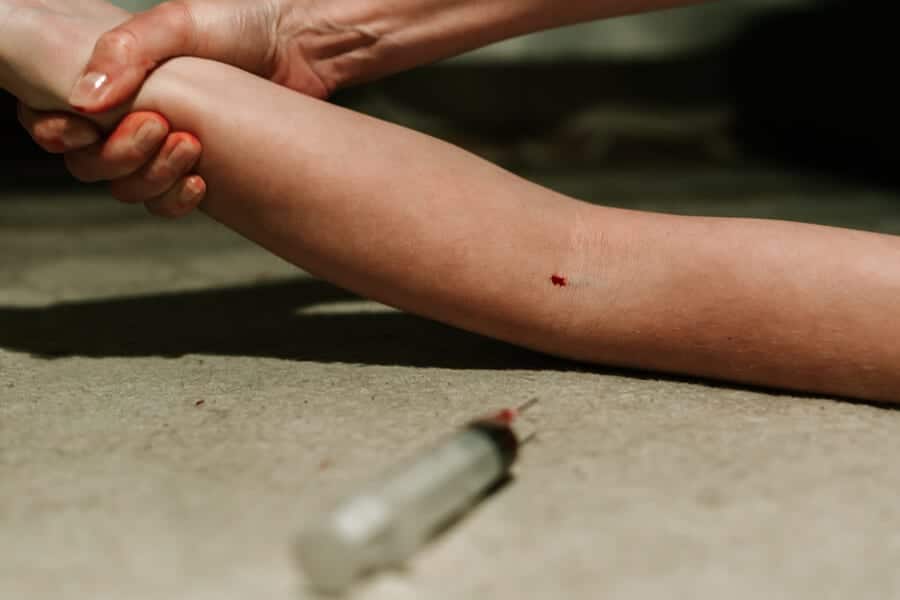What Do Track Marks Look Like?
Track marks, also known as injection marks or puncture marks, are visible signs of intravenous (IV) drug use. They appear as a result of repeated injections into the same areas, typically the arms, hands, feet, or legs. These marks can vary in appearance depending on factors such as the frequency of use, the user’s skin sensitivity, and the presence of any underlying health conditions.
Characteristics of Track Marks
Track marks can manifest in various ways, ranging from fresh puncture wounds to discolored scars. Here are some common characteristics of track marks:
Fresh Track Marks
- Puncture Wounds: Small, round holes in the skin where the needle has entered, often with a scab or dried blood around the site.
- Bruising: Discoloration and swelling around the injection site, indicating a “missed shot” or a vein that has been punctured through both sides.
- Redness and Inflammation: Signs of irritation or infection at the injection site.
Older Track Marks
- Scars: Raised, discolored skin at the injection site, often appearing as a thin line or cluster of marks.
- Hyperpigmentation: Darkening of the skin around the injection site, creating a contrast with the surrounding skin.
- Indented Veins: Veins that have become damaged and sunken due to repeated injections.
Locations of Track Marks
While track marks are most commonly found on the arms, they can appear on various parts of the body, including:
- Arms: The crooks of the elbows and the forearms are the most common sites for injection.
- Hands: Veins in the hands are often used when the arms become too damaged or scarred.
- Feet and Legs: The legs and feet are used when the arms and hands are no longer viable options.
- Groin: The groin area is sometimes used as a last resort when other injection sites have become unusable.
Factors Influencing the Appearance of Track Marks
The appearance of track marks can be influenced by several factors:
- Frequency of Use: The more frequently drugs are injected, the more pronounced and numerous the marks will be.
- Time Since Last Use: Fresh track marks will appear as open wounds or bruises, while older marks will appear as scars or discoloration.
- Skin Sensitivity: Some individuals may be more prone to scarring or discoloration due to their skin type or sensitivity.
- Underlying Health Conditions: Certain health conditions, such as diabetes or poor circulation, can affect the appearance and healing of track marks.
Risks Associated with Track Marks
Track marks are not only a visible sign of IV drug use but also indicate the potential for serious health risks, including:
- Infections: Repeated injections can lead to bacterial or viral infections, such as cellulitis, abscesses, or HIV/hepatitis C.
- Collapsed Veins: Damage to the veins can cause them to collapse, making future injections difficult and increasing the risk of infection.
- Overdose: IV drug use carries a higher risk of overdose due to the rapid absorption of the drug into the bloodstream.
Frequently Asked Questions (FAQ)
Q1: How long do track marks last?
The duration of track marks can vary depending on the individual’s skin type and the extent of the damage. Fresh marks may fade within a week or two, while older scars can take months or even years to fully heal.
Q2: Can track marks be removed?
While some fading of track marks is possible over time, complete removal often requires medical intervention, such as laser treatments or surgical scar revision. However, these procedures can be costly and may not always be effective.
Q3: Are track marks always a sign of drug addiction?
While track marks are a strong indicator of IV drug use, they do not necessarily mean that an individual is addicted to drugs. Some people may experiment with IV drug use without becoming addicted.
Q4: Can track marks lead to other health problems?
Yes, track marks can lead to various health problems, including infections, collapsed veins, and an increased risk of overdose. It is essential to seek medical attention if any signs of infection or other complications arise.
Q5: How can I help someone with track marks?
If you know someone with track marks, it is crucial to approach the situation with compassion and understanding. Encourage them to seek help for their drug use and provide support throughout the recovery process. Avoid judgment or confrontation, as these can be counterproductive.
Summary Table
| Characteristic | Description |
|---|---|
| Fresh Track Marks | Puncture wounds, bruising, redness, inflammation |
| Older Track Marks | Scars, hyperpigmentation, indented veins |
| Common Locations | Arms, hands, feet, legs, groin |
| Factors Influencing Appearance | Frequency of use, time since last use, skin sensitivity, underlying health conditions |
| Risks Associated | Infections, collapsed veins, overdose |
For more information on the health risks associated with IV drug use, you can refer to the Centers for Disease Control and Prevention (CDC) website.
Conclusion
Track marks are a visible sign of the damage caused by IV drug use. While they may fade over time, the underlying addiction and health risks remain. If you or someone you know is struggling with IV drug use, it is crucial to seek help from a qualified healthcare professional or addiction treatment provider. With proper support and treatment, recovery is possible, and the physical and emotional scars of addiction can begin to heal.



